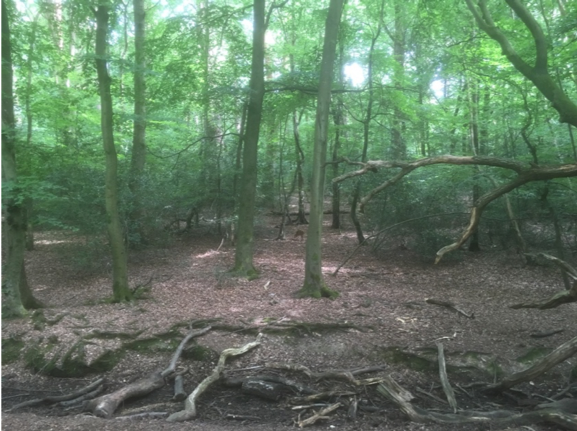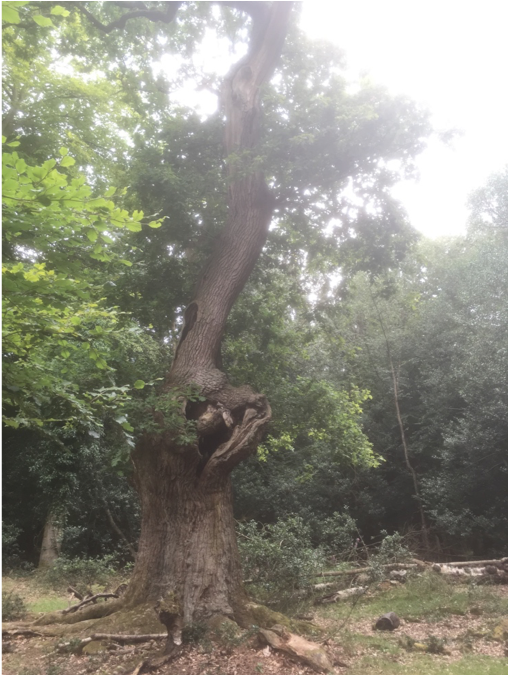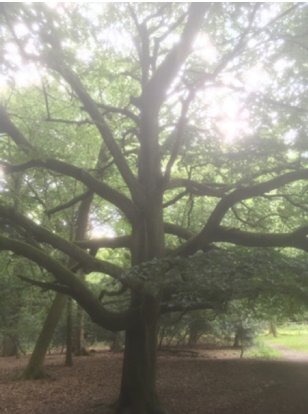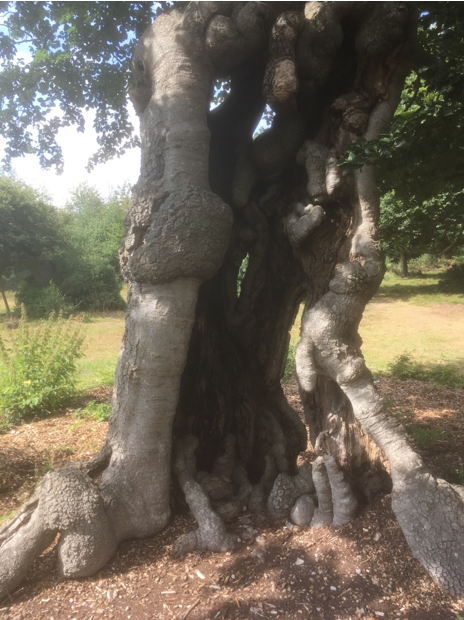Meet Burnham Beeches: an Important Ecosystem Shaped by Traditional Farming
Figure 1 Trunk of one tree growing into another. Photo by author, Helen George.
By Helen George
On a warm, sunny day in July my friends and I went to visit Burnham Beeches, a site of special scientific interest near London in the United Kingdom (UK). This 383.71 hectare woodland is a popular beauty spot where visitors can walk for hours under near continuous tree cover.
We admired the woodland for its beautiful beeches, ancient oaks and the unusual number of ant nests. Burnham Beeches is one of the UK’s richest sites for invertebrates that depend on dead or decaying wood. It’s also home to nationally important epiphytes (mosses, liverworts, lichens, algae and micro-fungi).
Burnham Beeches supports a complex ecosystem of flora and fauna. If it were to disappear, much more than trees would be lost. Fortunately, early proposals to build the HS2 high speed rail link just less than 400 metres away were abandoned.
Many of the trees at Burnham Beeches have an unusual shape. That’s because the woodland is a former beech wood pasture, where pollarding was regularly practised up until 200 years ago.
Pollarding is a method of pruning. The top of the tree is cut off, encouraging a dense growth of new branches from the poll (head) of the tree. Pollarding enabled country folk to gather leaves, twigs and bark for animal fodder, bark for tanning, and wood for fuel and charcoal.
(At Burnham Beeches a 400 to 500 year old pollarded beech known as the Cage Pollard appeared in the Kevin Costner movie Robin Hood: Prince of Thieves in 1991!).
Of the woodland’s original 3,000 pollards, only 400 remain. The lack of pollarding for two centuries led to very heavy branches growing on slim stems and many trees collapsed. The City of London, which owns the southern part of Burnham Beeches, has resumed pollarding to maintain the woodland.
In the UK it’s not unusual to find important ecosystems that depend on human management to stay healthy. Traditional fruit orchards are another example involving trees.
Figure 2 Woodland management includes leaving deadwood on the ground for the invertebrates. Photo by author.
The UK’s human population has shaped much of the countryside for hundreds of years. Nature has been forced to adapt around traditional farming practices. In the UK maintaining established ecosystems sometimes requires a knowledge of farming history.
Much of today’s wildlife crisis is caused by the shift away from traditional methods to larger scale industrialised farming. The removal of hedgerows to make fields bigger and the use of chemicals has had significant impacts on biodiversity.
In woodlands the move to commercial forestry methods and the decline of pollarding and coppicing has led to loss of habitats.
Meet the UK’s denuded landscape: a legacy of centuries of human activity
Most British people probably know that the island used to be heavily wooded. What may surprise some is how early deforestation began. I asked a British friend to guess the date. “At the industrial revolution?” He guessed, wrongly.
Britain lost most of its forests long before the 18th and 19th century period of industrialisation. In the 5th century (when the Romans withdrew from Britain) total tree cover on the entire island was a mere 15 percent! Thousands of years earlier, at the start of the Stone Age, Britain was almost completely forested.
With just 9.9 percent cover England is now one of the least forested areas in Europe. And Scotland’s famously beautiful but austere Highland slopes shouldn’t be like that either. The Highlands also used to be heavily wooded.
Figure 3 This ancient oak is a valuable habitat for small organisms. Photo by author.
Deforestation’s early impact on Britain means that its ancient woodlands have been drastically reduced from what they once were. In England, Wales, and Northern Ireland, the description “ancient woodland” is applied to any woodland that have existed since at least the year 1600. In Scotland the cut off point is 1750.
The value of even the youngest ancient woodland is that ecosystems have had several centuries to become established in the soil. For this reason, ancient woodland soil is irreplaceable. Woodland soil ecosystems include many types of fungi, invertebrates and worms.
The loss of woodland habitat has caused problems that extend beyond the loss of the trees themselves. Together with hunting, deforestation has had serious consequences for larger mammals in Britain. Brown bears disappeared around 1,500 years ago, lynx 1,300 years ago, and wolves 400 years ago in the 17th century.
Science has found that large predators help to keep ecosystems healthy. Predators control prey populations and maintain the balance of ecosystems. Today Britain’s largest mammal predators are knee-height at best: red foxes, badgers and the rare European wildcat, which exists only in Scotland. What would British nature be like if our larger predators had survived?
Britain’s largest wild mammals are now deer, accidentally reintroduced wild boar, and wild ponies. Without natural predators to keep their populations under control, these animals can cause damage to ecosystems through grazing, browsing and trampling.
Britain is an island. When animals disappear from an island they are permanently lost until humans reintroduce them again. This is why rewilding is such a popular topic of conversation among conservationists here. The Rewilding movement supports the reintroduction of lost animals to the UK.
Rewilding has already shown positive results. In recent years Eurasian beavers, missing since the 16th century, have returned to England, Scotland and Wales.
The new beaver population in Devon, southwest England, has noticeably improved biodiversity. By building dams, thinning out dense vegetation and creating pools and deadwood, the beavers are improving habitat structure and diversity. Researchers found improvements in the populations of bats, invertebrates and bryophytes.
Figure 4 A Tree showing evidence of pollarding through the upward rise of its branches. Photo by author.
What could rewilding do for ancient woodlands? An exciting project in southwest England will show how the return of bears, wolves and lynxes could help woodland ecosystems.
Run by Bristol Zoo and officially opened to the public on 25th July 2019, Bear Wood is 7.5 acres of ancient woodland surrounded by barriers. Wolves and bears live together in one part of the wood. Lynx and wolverine (extinct in Britain for 7,000 years) live together in the other part.
The Bear Wood project aims to highlight what’s been lost and will also demonstrate what could be gained by future introductions of large predators.
Unfortunately, with woodlands at risk and most of Britain still deforested, it’s unlikely that the island will be able to provide big predators with all the habitat they need.
Meet the Woodland Trust: defenders of British woodland
Founded in 1972, the Woodland Trust exists to defend ancient woodland, promote the planting of new trees and influence government policy towards trees. Deforestation in Britain has been so severe that every ancient woodland site must be protected with vigour.
Since the 1930s almost half of ancient broadleaved woodland in England and Wales has been planted with commercial conifers or cleared for agriculture. Britain only has three native species of conifer: the Yew, the Juniper and the Scots Pine. Many of the conifers grown on plantations are species that originate in North America and Scandinavia.
Only 3,090 square kilometres of ancient semi-natural woodland remain in Britain. That is less than 20 percent of the total wooded area.
Thanks to the Woodland Trust and others, the government’s 2019 National Planning Policy Framework for England contains new protections for trees.
The Framework is used by local governments in England when they decide on permission for new construction projects.
The revision to the Framework is a victory for trees and for the ecosystems they support. The Framework states:
“development resulting in the loss or deterioration of irreplaceable habitats (such as ancient woodland and ancient or veteran trees) should be refused, unless there are wholly exceptional reasons and a suitable compensation strategy exists.”
The Woodland Trust has released the Planners’ Manual for Ancient Woodland and Veteran Trees to raise awareness of the new policies.
In England, members of the public can make formal objections at certain stages of the planning permission process. Therefore, the manual is a useful guide not only for local government officers but also for the public.
The manual gives advice on ways to protect and support trees and woodlands near construction projects.
One useful tip is that developers should plant buffer zones of trees and shrubs between ancient woods and new developments. These newly planted buffer areas, sometimes more than 100 metres wide, can shield ancient woodlands from noise and light pollution, invasive garden plants, wandering pets and other disturbances.
Another useful piece of advice applies to veteran trees. Veteran trees are trees of any age which show ancient characteristics due to damage. Ancient characteristics vary between species but tend to include a wide, hollowed trunk and a low fat, squat shape.
Veteran trees have ecological importance because of the species that live on deadwood habitats and in structurally complex branches.
The manual suggests placing felled veteran trees next to surviving veterans to give communities the chance to migrate to a new habitat.
The Woodland Trust’s manual highlights the ecological value of woodlands that have been very heavily shaped by human management. It encourages the public and local government officers not to dismiss woodlands that may appear to have little ecological value, such as commercial conifer plantations.
In 1900 Britain’s woodland coverage was at an all time low of 4.7 percent. It increased in the 20th century because the government established plantations of conifers for commercial use.
Unless well managed, the plantations are not great news ecologically. Dark, densely packed forests of non-native trees are a habitat for some wildlife but not attractive to all the natural communities that could live in a woodland. Regeneration of these woodlands includes ensuring a mosaic of tree species, letting light onto the forest floor and maintaining open areas.
When plantations stand on ancient woodland soil that is very good news. The ancient woodland’s soil ecosystems may still survive. For this reason Plantations on Ancient Woodland Sites are protected under the National Planning Policy Framework.
The protection offered by the Framework is a boost for conservationists working to improve biodiversity on these plantation sites.
The Woodland Trust’s manual and the Framework also calls attention to ancient woodlands with only 20 percent tree cover. To the untrained eye these areas may look like open fields with a few trees scattered around them. Developers might imagine that building a few houses on these sites does no harm.
However, in England these low density woodlands may be very old, originating in medieval hunting forests, shared grazing land, and the landscaped parklands of the aristocracy. Many collections of ancient trees can be found near the grand houses of Britain’s nobility.
Meet Earth Law: a way to increase protection for ancient woodlands and all trees
The National Planning Policy Framework is a significant step forward for trees but it’s not perfect.
Figure 5 Ancient tree with hollow trunk at Burnham Beeches. An ancient tree is a tree that is old for its species. All ancient trees are veteran trees, but not all veterans are ancient. Photo by author.
It does not mention urban trees. These are important to the urban ecosystem as habitats, air filters and carbon storage mechanisms. In London there are 8,421,000 trees. The total tree canopy cover is 21.9 percent! That makes London an urban forest.
Another problem with the National Planning Policy Framework is that it allows for human needs to be placed above the needs of ancient woodland in cases such as “nationally significant infrastructure projects … where the public benefit would clearly outweigh the loss of deterioration of habitat.”
At present, as highlighted by the Woodland Trust, 108 ancient woodlands are threatened by the controversial HS2 high speed rail project. The proposed rail line will travel from London to the north, connecting Birmingham, London, Leeds, Manchester, Liverpool, Sheffield, Edinburgh and Glasgow.
The National Planning Policy Framework places human transport needs above the needs of irreplaceable ancient woodlands. It is not an Earth Law Framework at present, but in the future that could change. The Framework has been revised in the past and will be revised again in the future. One day it could include Earth Law thinking.
Earth Law gives equal value to the needs of all members of the natural community. Under Earth Law economic benefits to humans are never of greater importance than an ecosystem’s right to thrive and survive. Earth Law practitioners understand that healthy ecosystems ensure the long term survival of the human species.
If planning policy already included Earth Law thinking, 108 ancient woodlands would not be under threat from HS2. Instead, the rail project would always prioritise looking for alternative routes and ways to pass through the landscape without disturbing it.
Britain is a heavily deforested island but the situation for trees is improving thanks to the hard work of the Woodland Trust and other organisations. Introducing Earth Law to England, Wales and Scotland would help to protect all trees.
If you are a tree supporter in Britain or anywhere else in the world, contact Earth Law Center for advice and information on Earth Law:





